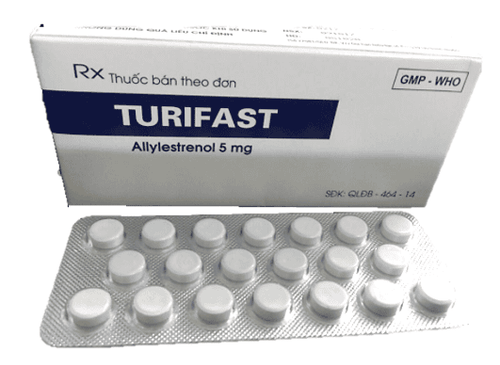This is an automatically translated article.
The article was professionally consulted by Specialist Doctor Obstetrician and Gynecologist - Department of Obstetrics and Gynecology - Vinmec Hai Phong International General Hospital. The doctor has many years of experience in the field of obstetrics and gynecology.
A baby is said to be born premature if it is not delivered before 37 weeks of pregnancy. Compared with full-term infants, premature babies have a higher risk of many diseases such as developmental disabilities, cerebral palsy, visual and hearing impairments. The fewer weeks a baby is born prematurely, the higher the risk.
1. What is Premature Labor?
Premature labor is defined as regular uterine contractions leading to changes in the cervix, threatening preterm labor, before the fetus is 37 weeks old.
Changes in the cervix during early labor include effacement (the cervix moves out) and dilation (the cervix opens up so the fetus can enter the birth canal). In some cases, early labor can put the baby at risk of being born prematurely.
Trắc nghiệm: Thế nào là trẻ sơ sinh non tháng?
Trẻ sơ sinh non tháng rất cần được chăm và điều trị thật tốt để giúp giảm nguy cơ gặp phải các di chứng về tinh thần, vận động và sự phát triển sau này. Cùng theo dõi bài trắc nghiệm dưới đây để có thể nhận biết trẻ sơ sinh non tháng và có thêm kiến thức chăm sóc, nuôi dưỡng tốt nhất cho trẻ.The following content is prepared under supervision of Thạc sĩ, Bác sĩ y khoa, Ma Văn Thấm , Nhi , Phòng khám Đa khoa Quốc tế Vinmec Dương Đông(Phú Quốc)
2. What is preterm birth?
Premature birth is defined as when a baby is born too early. When a pregnant woman gives birth and gives birth to a baby between the 20th and 37th weeks of pregnancy, it is called preterm. Pregnant women need to learn the causes of threatened preterm birth to prevent as much as possible.
3. Risks of premature babies
Babies born prematurely may be at certain risks because babies born too early may not be fully developed. Babies born prematurely often face many serious health problems; such as cerebral palsy, which usually lasts a lifetime. Other problems, such as cognitive impairment, may appear later in preschool or even later in adulthood.
The risk of health problems is highest for babies born before 34 weeks of pregnancy. However, babies born between 34 and 37 weeks of pregnancy are also at certain risk.
4. Causes of threatened preterm birth
The following factors increase the risk of preterm birth, including:
Having a history of premature birth. Having a short cervix is a risk factor for preterm birth. The interval between two pregnancies is too short. Have had surgery on the uterus or cervix in the past. Certain pregnancy disorders, such as multiple pregnancies or vaginal bleeding. Lifestyle factors such as inactivity, low birth weight, malnutrition, chronic stress and substance abuse (smoking, alcohol consumption) during pregnancy.
5. Preventing premature birth with high-risk subjects
If you've had a preterm birth before and you're planning on having another baby before, it's important to get prenatal care checked to get the best health possible before you get pregnant. During pregnancy, start choosing a prenatal care package as soon as possible.
An obstetrician-gynecologist will closely control the risks and causes of threatened preterm birth that may occur during pregnancy, especially for mothers at high risk. In addition, women are often given certain medications or given a protocol to prevent preterm labor. The method of prevention is considered by the doctor based on each individual's condition and risk factors for preterm birth.

6. Signs of threat of premature birth
Call your obstetrician or go to the hospital right away if you notice any of the following signs or symptoms of preterm labor:
Change in vaginal discharge (fluid, mucous discharge) more or with blood). Increased vaginal discharge. Increased pressure in the pelvis or lower abdomen. Constant, dull low back pain. Mild cramps in the abdomen. Cramping pain that resembles menstrual cramps, or pain that is accompanied by continuous uterine contractions. Amniotic fluid rupture (seeing amniotic fluid appear and flow out, sometimes just a drop of fluid).
7. Diagnosis of preterm labor
Preterm labor can only be diagnosed when changes are noticed in the cervix. Your doctor will perform a pelvic exam to determine the condition of the cervical area. It is likely that you will need to have multiple check-ups within a few hours. Contractions will also be recorded and closely monitored.
In addition, the doctor will do some of the following tests to determine if you need to be hospitalized:
Transvaginal ultrasound: To measure the length of your cervix. fFN test: Measures the concentration of a protein (called fibronectin) of the fetus in vaginal discharge. The presence of this protein helps predict the risk of premature birth. If the doctor realizes that the pregnant woman's condition is in danger, the doctor will immediately deploy an emergency.
8. Risk of preterm labor when pregnant women go into labor early
Health professionals cannot predict exactly which women in early labor will give birth prematurely. Statistically, only about 1 in 10 women who go into early labor leads to childbirth within the next 7 days. And about 3 out of 10 women who experience early labor go into labor on their own and don't show any symptoms for a long time afterward.
9. Controlling Premature Labor

If you continue to experience contractions threatening to give birth, you need to be cared for and controlled with the most appropriate regimen for the health of both mother and fetus. On the other hand, this is sometimes beneficial to the development of the fetus when it is possible to delay the time of delivery. Some drugs are prescribed by doctors to deal with spasms threatening preterm labor of pregnant women, including:
Corticosteroids: A drug that has the ability to cross the placenta and help speed up the development of organs of the pregnant woman. fetus such as lungs, brain and digestive system. Magnesium sulfate: Helps reduce the risk of cerebral palsy associated with preterm birth, in addition to reducing spasms. Tocolytics: To delay the time of childbirth for a short time (not more than 48 hours). During that time, the doctor can promptly administer corticosteroids or magnesium sulfate to the pregnant woman, or refer the pregnant woman to a hospital with more expertise in handling preterm births.
If you feel you are at high risk of preterm birth, talk to your doctor as soon as possible so that you can promptly recognize the signs of threatened preterm labor and have the best treatment.
The Maternity Package at Vinmec International General Hospital helps customers complete antenatal check-ups and necessary tests during pregnancy, in order to minimize the risk of preterm birth. Customers registered for Maternity Package are fully cared for and checked for health of mother and baby before birth - during childbirth and after birth, fully and conscientiously.
Please dial HOTLINE for more information or register for an appointment HERE. Download MyVinmec app to make appointments faster and to manage your bookings easily.














